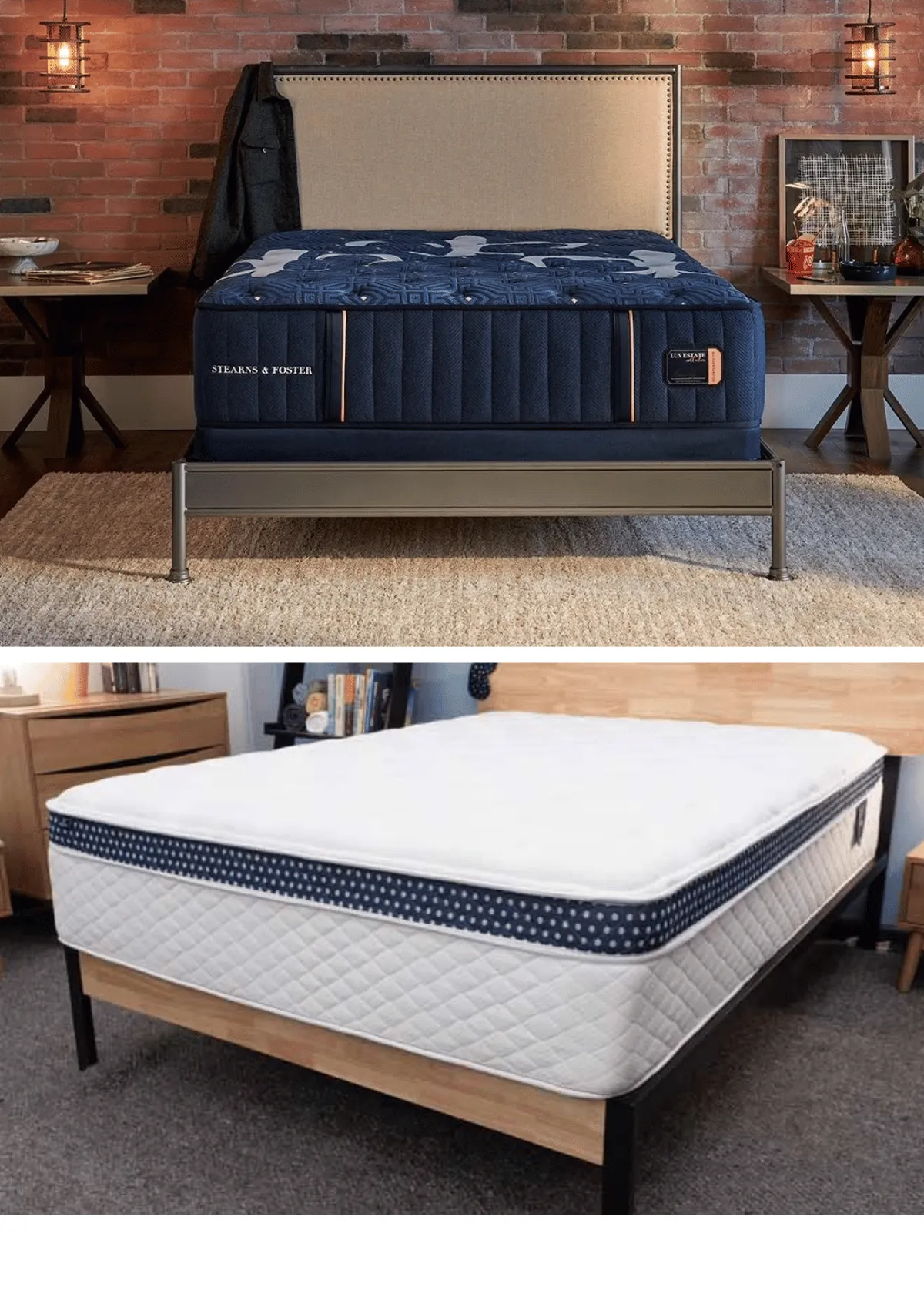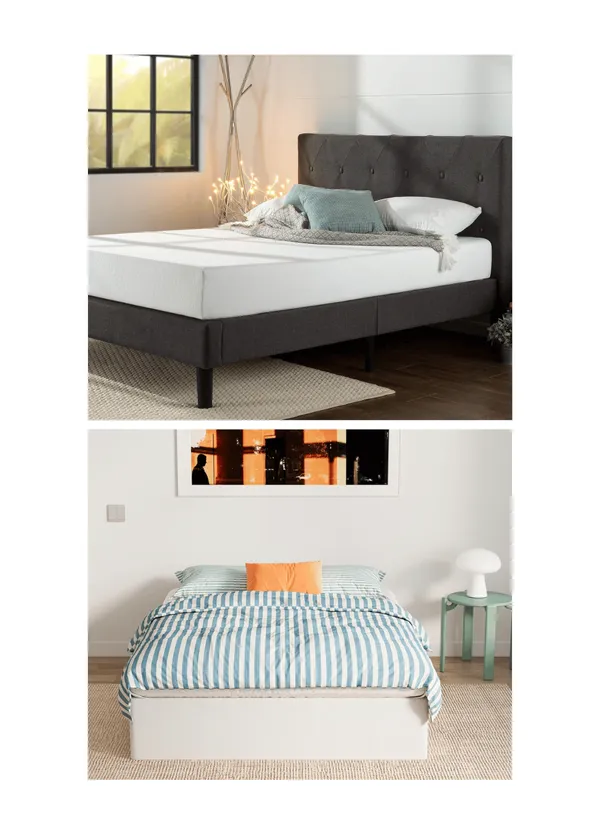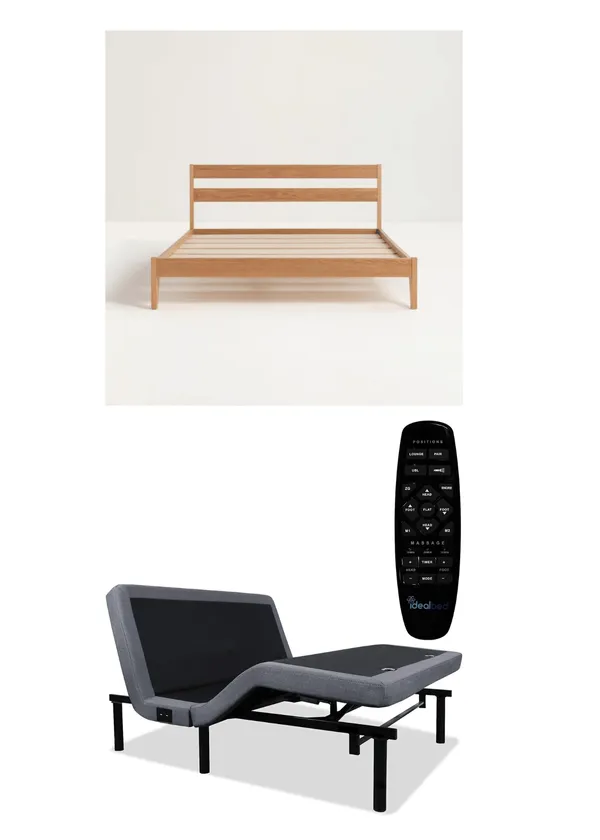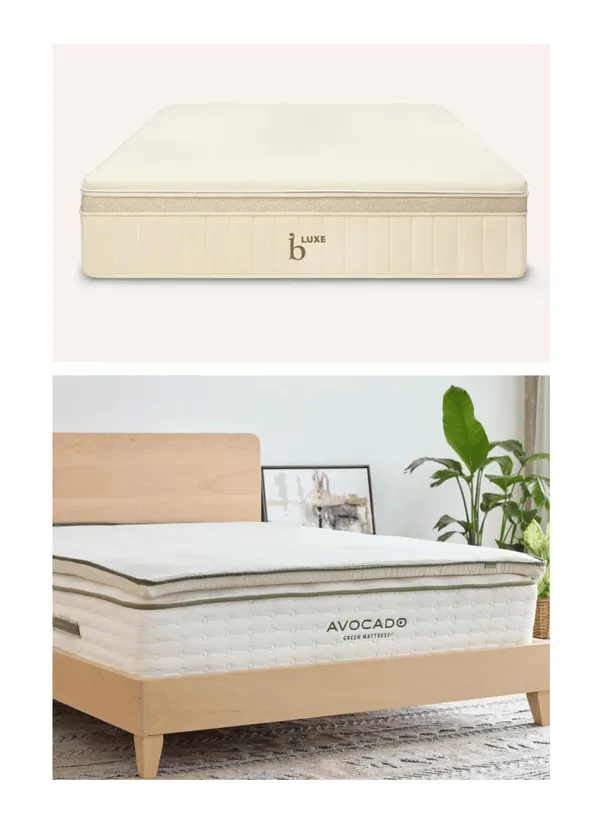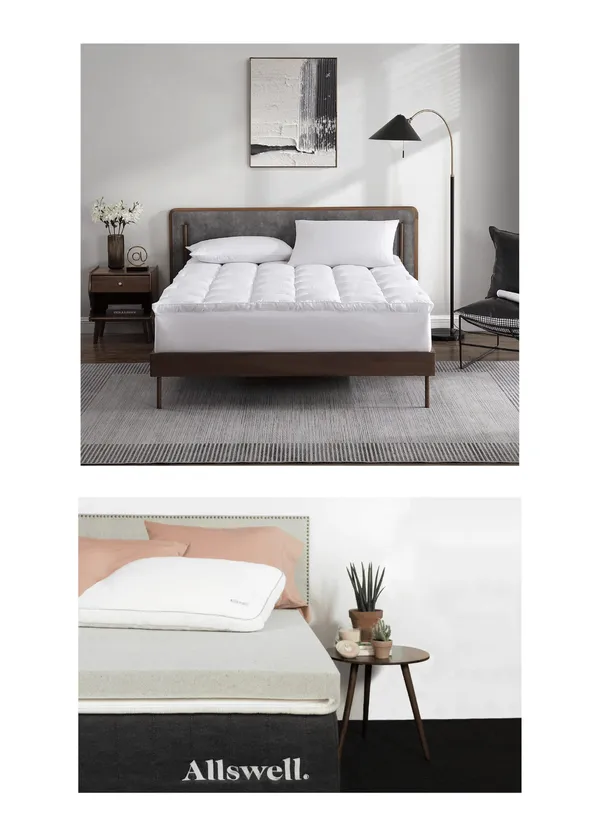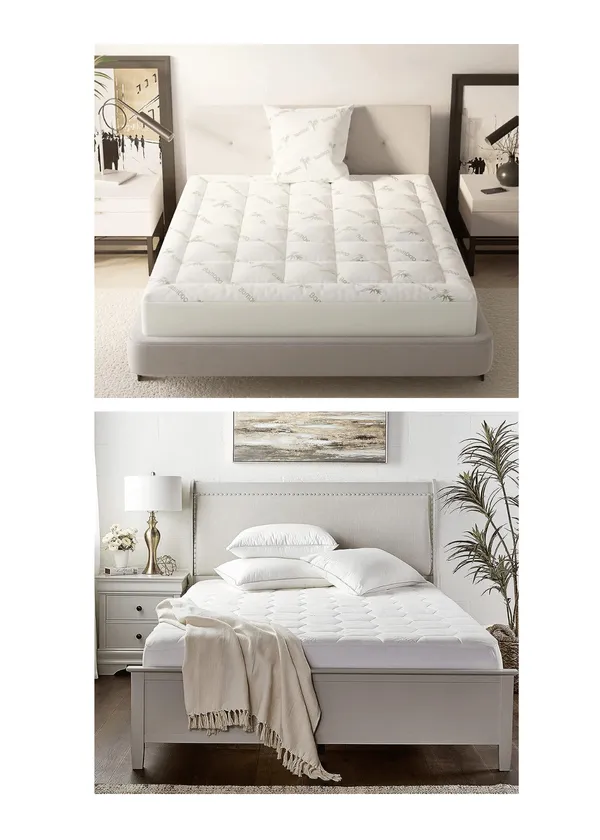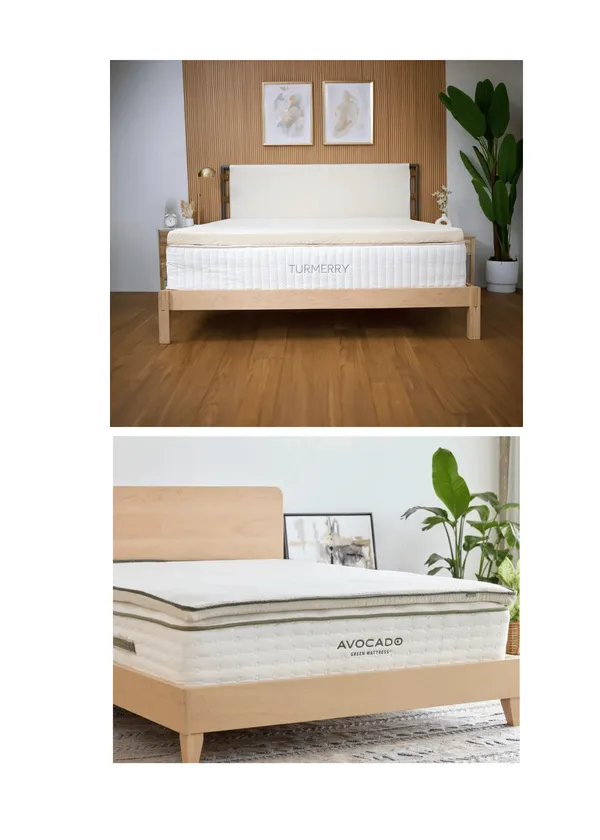(Last Update: 04/29/2024)
Ever tossed and turned all night, only to wake up more exhausted than when you went to bed? The culprit might be right under you.
The mattress you sleep on is pivotal in your sleep quality, impacting your rest and overall health. With countless options out there, how do you select the right one?
Whether you're a side sleeper, prefer organic materials, or are on a budget, understanding mattress features can lead you to your dream sleep.
Dive in with us as we explore the best mattress features tailored for every sleeper, budget, and need.
Understanding Different Sleeper Needs
Side Sleepers:
Example of Mattress: Helix Midnight Luxe Mattress

Helix Midnight Luxe: Sleep perfection in every feature
(Credit: Helix Sleep)
The Helix Midnight Luxe Mattress is a luxury hybrid mattress that offers excellent comfort and support to side sleepers.
It is made with high-quality materials, and a unique adaptive foam layer relieves personalized pressure points. A lifetime warranty also backs the Helix Midnight Luxe Mattress.
Characteristics and Challenges:
Most people identify as side sleepers, making this the most common sleep position. The challenge for side sleepers is the pressure on the shoulders and hips, which can lead to discomfort if not addressed.
Memory foam mattress toppers can be a boon for side sleepers. The mattress feels soft and cushioning, especially beneficial for those with hip or shoulder discomfort.
Optimal Mattress Features:
A mattress that offers support and contouring is ideal for side sleepers. Memory foam or hybrid mattresses are often recommended because they adapt to the body's shape, relieving pressure points and ensuring the spine's natural alignment.
Back Sleepers:
Example of Bed: Brooklyn Bedding Sedona Elite Mattress

Brooklyn Bedding Sedona Elite: Elite features, elite dreams
(Credit: Helix Sleep)
The Brooklyn Bedding Sedona Elite Mattress is a great example of a well-suited bed for back sleepers.
Its medium-plush firmness and zoned support provide the perfect balance of comfort and support for the back, helping to keep the spine in alignment and relieve pressure points.
The best sleeping position for the Brooklyn Bedding Sedona Elite Mattress is the one that feels most comfortable to you and helps you maintain a neutral spine alignment.
Characteristics and Challenges:
Back sleepers lie flat, supporting the spine's natural curve. However, there's a risk of the lower back sinking too much, leading to lumbar strain and discomfort.
Back pain can be alleviated by choosing the right mattress. Traditional mattresses with a comfort layer can support those who sleep on their back.
Optimal Mattress Features:
A firmer mattress is usually the go-to for sleepers. Innerspring and hybrid mattresses, with their supportive coil systems, provide the rigidity needed. Some contouring can also be beneficial, especially if the mattress offers zoned support tailored to the body's different regions.
Stomach Sleepers:
Example of Bed: Nolah Evolution Hybrid Mattress

Nolah Evolution Hybrid: Merging comfort features seamlessly
(Credit: Helix Sleep)
The mattresses cost
The Nolah Evolution Hybrid Mattress is a great example of a bed for stomach sleepers due to its firm support and pressure point relief. It helps to keep the spine in alignment and prevents the hips from sinking in too far, reducing the risk of back pain.
Characteristics and Challenges:
Stomach sleeping is less common and can be challenging for spinal alignment. The primary concern with stomach sleepers is the hips sinking into the perfect mattress, causing an unnatural curve in the spine.
Optimal Mattress Features:
A firmer mattress type is crucial for stomach sleepers. Denser memory foam or innerspring varieties tend to offer the resistance required to keep the hips elevated.
Additionally, stomach sleepers should consider pillow choices carefully, often opting for flatter options or skipping a pillow to keep the neck in line.
Combination Sleepers:
Example of Mattress: Saatva Solaire Mattress

Saatva Solaire: Solitary features for restful solace
(Credit: Saatva)
The best sleep position for the Saatva Solaire Mattress is the one that feels most comfortable to you and helps you maintain a neutral spine alignment.
However, in general, the Saatva Solaire is a good choice for all sleep positions, as it offers a variety of firmness levels that can be adjusted to suit individual needs.
The best sleeping position for the Saatva Solaire Mattress is the one that feels most comfortable to you and helps you maintain a neutral spine alignment.
Characteristics and Challenges:
As the term suggests, Combination sleepers move through multiple positions in one night. This dynamic sleeping style requires a versatile mattress solution.
Optimal Mattress Features:
A medium-firm mattress usually serves sleepers best. Hybrid or latex mattresses, with their mix of bounce and contouring, can cater to the changing demands of combination sleepers, ensuring comfort regardless of position.
Material Type and Its Benefits
Memory Foam Mattresses: Comfort and Pressure Point Relief
Example of Mattress: Casper Wave Hybrid Mattress

Casper Wave Hybrid: Sleep-enhancing features throughout
(Credit: Casper Sleep)
The Casper Wave Hybrid Mattress combines the best of both worlds: the pressure relief and comfort of memory foam and the support and durability of coils.
It is made with high-quality materials and features a unique zoned support system that provides personalized support for different body parts. A 10-year warranty also backs the Casper Wave Hybrid bed.
Characteristics of Memory Foam:
A standout in mattress materials, memory foam is known for its viscoelastic properties. This means it softens with body heat, allowing sleepers to sink in slightly and offering a cradling effect.
Benefits for Sleepers:
The all-foam mattress is particularly beneficial for side sleepers and those with chronic pain. It molds to the body, providing unparalleled pressure point relief. This contouring supports natural spinal alignment, reducing the risk of waking up with aches and pains.
The all-foam mattresses, made up of premium memory foam layers, provide superior contouring.
Often, they include gel memory foam, ensuring users don't sleep hot. The all-foam foam mattress might be your perfect choice if you're seeking a soft mattress that adjusts to your body's contours.
Innerspring Mattresses: Traditional Support and Bounce
Example of Mattress: Stearns & Foster Estate Mattress

Stearns & Foster Estate: Timeless features, timeless sleep
(Credit: Stearns & Foster )
The mattresses cost
Innerspring mattresses tend to provide bounce and support. The Stearns & Foster Estate Mattress is a luxurious innerspring mattress known for its comfort and support.
The pillow top mattresses have high-quality materials and a unique adaptive support system for personalized pressure relief.
A lifetime warranty also backs the Stearns & Foster Estate Mattress. Characteristics of Innerspring beds: Innerspring mattresses are traditional and have been around for decades.
Benefits for Sleepers:
Innerspring mattresses offer a classic feel with a noticeable bounce. This responsiveness makes them suitable for back and stomach sleepers who require substantial support.
Innerspring mattresses are traditional mattresses, often chosen for their bounce. Some innerspring mattresses include a pillow top for added comfort.
While most mattresses have evolved, traditional innerspring mattresses still find favor among many, especially those who recommend innerspring mattresses for their support.
Latex: Bounce, Contouring, and Durability
Example of Mattress: Avocado Green Mattress

Avocado Green: Eco-friendly features for peaceful rest
(Credit: Avocado Green Mattress )
Characteristics of Latex:
Latex, derived from the sap of rubber trees, combines the best qualities of latex bed memory foam and innerspring. It's available in natural, synthetic latex, or blended varieties.
Benefits for Sleepers:
Latex mattresses offer a unique combination of bounce and contouring. They respond quickly to movement, making them great for sleepers.
Latex mattresses can be made from natural latex or synthetic latex. They offer a blend of support and cushioning. Many people choose a mattress of this type for its eco-friendly properties, especially when they opt for an organic mattress.
Additionally, latex foam is known for its durability and can outlast many other mattress types. It's also hypoallergenic and resistant to dust mites, benefiting allergy sufferers.
Hybrid: The Best of Both Worlds
Example of Mattress: DreamCloud Luxury Hybrid Mattress

DreamCloud Luxury Hybrid: Features crafted for dreamy depths
(Credit: DreamCloud Sleep)
The DreamCloud Luxury Hybrid Mattress is a hybrid mattress known for its luxurious comfort and support. Made with high-quality materials, it features a unique quilted cover that provides a soft and cozy feel. A lifetime warranty also backs the DreamCloud Luxury Hybrid Mattress types.
Characteristics of a Hybrid mattress:
Hybrid mattresses combine the supportive coil system of innerspring with the contouring comfort of foam or latex. They're crafted to offer a balanced sleeping experience.
A hybrid bed combines the best mattress features of innerspring and foam mattresses. With comfort layers of gel memory foam and the supportive bounce of an innerspring bed, they offer a balanced sleep experience.
Benefits for Sleepers:
For those who want both bounce and cushioning, hybrids are the answer. They cater to a broad range of sleepers, offering the support of steel coils along with the pressure-relieving benefits of foam or latex. This dual structure also aids in temperature regulation, ensuring a cooler sleep.
Airbed Mattress: Customizable Firmness
Example of Mattress: SoundAsleep Dream Series Air Mattress

SoundAsleep Dream Series: Air mattress, premium features
(Credit: SoundAsleep)
The SoundAsleep Dream Series Air Bed is a luxurious mattress known for its comfort and support. Made with high-quality materials, it features a unique air chamber system that provides personalized pressure relief. A 5-year warranty also backs the SoundAsleep Dream Series Air bed.
Characteristics of Airbed:
Distinct from other mattresses, airbeds use air chambers to determine their firmness. These chambers can be adjusted manually or with a remote to change the bed's feel.
Diving into Firmness Levels
Soft to Extra Firm: What does it mean?
Firmness in mattresses refers to the feel of the bed and how much pushback it provides. It's more than the quality or durability but the comfort level. Softer mattress types will allow you to sink in more, offering a cloud-like feel, while an extra firm one provides a more solid, less contouring surface.
How weight and sleeping position affect your choice.
- Lighter Individuals:
- Soft to Medium: Lighter individuals, weighing less than 130 pounds, often prefer softer mattresses. A plush surface offers the contouring they might not get from a firmer bed.
- Average Weight Individuals:
- Medium to Firm: Those in the average weight range (130-230 pounds) usually gravitate towards medium to firm mattresses. These provide a balance of support and contouring.
- Heavier Individuals:
- Medium-Firm to Extra Firm: Weighing over 230 pounds, heavier sleepers often need a firmer bed. This ensures adequate support and prevents excessive sinking.
Side Sleepers:
Regardless of weight, side sleepers generally benefit from a softer to medium-firm mattress. This allows the mattress to conform to the body's curves, supporting the shoulders and hips.
Back and Stomach Sleepers:
A stomach or back sleeper often requires a firmer bed type. Innerspring mattresses or hybrids with a firmer comfort layer can be ideal. These positions require a firmer surface for optimal spinal alignment. Medium-firm to firm mattresses can prevent the lumbar area from sinking, which could lead to back pain.
Combination Sleepers:
A combination sleeper needs a versatile mattress. Memory foam beds or hybrid mattresses can be great since they cater to various sleeping postures.
Sleepers often fare best with medium- to medium-firm mattresses, given their varied positions. This ensures adaptability throughout the night's movements.
Cooling Features for Hot Sleepers
??? Example of Bed for Those Who Sleep Hot: Tempur-Pedic TEMPUR-breeze° Luxe Breeze Mattress

Tempur-Pedic TEMPUR-breeze°: Cooling features for hotter nights
(Credit: Tempur-Pedic)
The Tempur-Pedic TEMPUR-breeze° Luxe Breeze Mattress is a luxury hybrid mattress that keeps you cool and comfortable all night.
It is made with high-quality materials and features a unique cooling technology that helps to regulate your temperature. A 25-year warranty also backs the Tempur-Pedic TEMPUR-breeze° Luxe Breeze Mattress.
Example of Bed: Nectar Premier Copper Mattress
Gel-infused Memory Foam:
Traditional memory foam, though comfortable, often retains heat. To combat this, manufacturers introduced gel-infused memory foam.
The gel particles or beads effectively draw heat away from the sleeper, dispersing it throughout the mattress. This results in a cooler sleeping surface, allowing for undisturbed rest.
Open Cell Structure:
The open cell structure is a significant evolution in foam technology. Instead of tightly packed cells, open-cell foams are designed with a more porous composition.
This structure promotes greater breathability, ensuring that heat doesn’t become trapped. As a result, sleepers experience a more temperature-neutral environment.
Breathable Covers:
The cover of a mattress can play a pivotal role in temperature regulation. Opting for covers made of breathable materials like cotton, bamboo, or certain performance fabrics can make a noticeable difference.
These fabrics wick away moisture and allow for better air circulation, reducing the chances of overheating.
Innerspring and Airflow:
Innerspring mattresses inherently offer excellent airflow due to their coil construction. The spaces between the coils allow for continuous air circulation, ensuring heat doesn’t accumulate.
An innerspring mattress (or a hybrid variant with cooling foam layers) can be an excellent choice for temperature regulation for hot sleepers. Online or brick-and-mortar Mattress stores offer a plethora of mattress types.
From air mattresses to foam beds, the choice can be overwhelming. Consider mattress dimensions, sleeping position, and personal preferences when seeking a new bed.
Other Key Features You Don't Want to Miss!
Edge Support: Importance and Benefits
Why Edge Support Matters:
No one wants to feel like they're about to roll off the bed. Edge support ensures the mattress maintains its structure, especially at its periphery. This feature is crucial for those sitting or sleeping close to the bed's edge.
Types of Edge Support:
- Foam Encasement: Uses high-density foam around the mattress perimeter.
- Steel Rods: Positioned at the mattress's edge to reinforce it.
- Innerspring Systems: Certain coil structures enhance edge support by design.
Enhancing the Sleep Surface:
With proper edge support, the entire surface of the mattress becomes usable. This means even if two people share a smaller bed, they can utilize the full expanse without fear of sagging edges.
Memory Foam Mattress and Motion Isolation: A Must-have for Couples
The Science Behind It:
Motion isolation ensures that the other person isn't disturbed when one person moves or shifts on the bed. This is particularly essential for light sleepers sharing a bed.
Materials Offering Motion Transfer:
- Memory Foam: Naturally excels at absorbing motion.
- Pocketed Coils: Individual coils wrapped in fabric pockets move independently.
- Latex: Natural latex offers good motion transfer due to its density.
Peaceful Nights, Every Night:
Motion transfer can differentiate between a restless night and deep, uninterrupted sleep for couples. It's a feature that can greatly enhance sleep.
Hypoallergenic Materials: For Allergy-Free Nights
Allergies and Sleep:
Allergies can be a significant disruptor of quality sleep. A mattress that harbors dust mites, mold, or other allergens can exacerbate symptoms and disturb rest.
Common Hypoallergenic Materials:
- Natural Latex: Resistant to mold, mildew, and dust mites.
- Organic Cotton: Breathable and less likely to irritate.
- Bamboo Covers: Naturally hypoallergenic and antibacterial.
Investing in Health:
A hypoallergenic mattress is a good choice for allergy sufferers and those seeking a healthier sleep environment.
Sleeping in Alignment:
Zoned support ensures that each body part gets its required support, promoting proper spinal alignment and reducing pressure points.
Adjustable Base Compatibility: The Future of Sleeping
Why It’s the Future:
Adjustable bases, paired with compatible mattresses, allow users to change their sleeping position at the push of a button. This brings a new level of customization to sleep.
Benefits of Adjustable Bases:
- Health Benefits: Elevating the head or feet can aid in conditions like acid reflux or poor circulation.
- Lifestyle Benefits: Watch TV, read, or work in bed more comfortably.
- Sleep Benefits: Find the perfect angle for snoring reduction or pressure relief.
Pairing with the Right Mattress:
Not all mattresses are suitable for adjustable bases. Please ensure your mattress is flexible and durable enough to handle the movement.
Understanding these features in the evolving world of mattresses can drastically improve your sleep experience.
Going Green: Organic & Natural Mattress Choices
Example of Bed: WinkBed Plus Mattress

WinkBed Plus: Plus-size features for ultimate sleep
(Credit: WinkBeds)
The WinkBed Plus Mattress is a hybrid mattress designed for heavier sleepers. It is made with high-quality materials and features a unique zoned support system that provides additional support for the hips and lumbar region. A lifetime warranty also backs the WinkBed Plus Mattress.
The mattress industry has been included in an era of increasing environmental consciousness. Consumers are becoming more discerning, gravitating towards sustainable and non-toxic options for their bedrooms.
The Rise of Organic Materials:
Organic mattresses have surged in popularity recently. It's not just a trend; it's a response to a demand for products free from harmful chemicals and pesticides.
These mattresses often use organic cotton, wool, and natural latex. Unlike their conventional counterparts, these materials are grown or sourced without synthetic fertilizers, pesticides, or other potentially harmful chemicals.
Benefits for Health and Environment:
Health Benefits:
- Reduced Chemical Exposure: Organic mattresses typically contain fewer volatile organic compounds (VOCs), which can off-gas and affect indoor air quality.
- Hypoallergenic Properties: Naturally sourced materials often resist dust mites, mold, and mildew, reducing allergy triggers.
- Non-Toxic Fire Retardants: Organic mattresses often utilize wool or other natural materials that inherently resist flames instead of chemicals.
Environmental Benefits:
- Sustainable Farming: Organic farming practices are less damaging to the earth, preserving soil health and reducing water usage.
- Less Pollution: Conventional mattress manufacturing can release air, water, and soil pollutants. Organic processes aim to minimize these impacts.
- Biodegradability: Natural materials are more likely to decompose without leaving harmful residues, reducing landfill waste.
Embracing organic and natural mattress choices is not merely a nod to a trend but a conscious decision to prioritize health and the environment.
Durability, Warranty, and Trial Periods
How Long Should a Mattress Last?
The lifespan of a mattress varies depending on its type, quality, and usage. On average, a standard mattress should last between 7 to 10 years.
However, high-quality materials and proper care can extend this timeline. For instance, latex mattresses, known for their resilience, can last up to 15 years or more, while innerspring mattresses might show signs of wear earlier, around the 7-year mark.
Monitoring your mattress's comfort and support is essential, as these can degrade over time, affecting sleep.
Material Matters:
Different materials have varied durability. Due to their inherent properties, polyurethane foam and latex tend to have longer lifespans. In contrast, innerspring or hybrid mattresses might require replacement sooner due to potential coil sagging or foam breakdown.
Navigating Warranties and Trial Periods:
The mattress industry has recognized the importance of offering peace of mind to consumers. As a result, warranties and trial periods have become more consumer-friendly.
Warranty Wisdom:
Warranties protect against manufacturing defects and not against natural wear and tear. It's vital to understand the terms:
- Duration: Most high-quality mattresses offer warranties spanning 10 to 25 years.
- Prorated vs. Non-Prorated: Non-prorated warranties cover the full cost of repair or replacement for a specified period, whereas prorated ones might require the consumer to cover a portion of the costs over time.
- Specifics Covered: It's essential to know what the warranty covers, such as sagging depth, coil malfunction, or foam breakdown.
The Trial and Truth:
Many modern mattress brands offer trial periods, especially those selling online. This is an opportunity for consumers to test the mattress in their homes:
- Duration: Typically ranging from 30 to 365 nights, giving ample time to adjust.
- Return Policy: Understand the return process. Some companies offer free returns, while others might charge a fee or ask for the mattress to be donated.
- Break-In Period: Some companies require you to keep the mattress for a minimum number of nights before initiating a return, ensuring you give it a proper chance.
Hygiene Matters: Removable & Washable Covers
Hygiene Matters: Removable and washable Covers
A good night’s sleep isn’t just about comfort; it’s deeply intertwined with the cleanliness of your sleeping environment.
Maintaining a hygienic mattress becomes paramount, with the average person spending about a third of their life in bed. One of the most significant innovations to assist in this realm is the advent of removable and washable mattress covers.
The Importance of Cleanliness:
The mattress can be a breeding ground for dust mites, allergens, and bacteria, particularly if you often eat in bed or have pets that share the space.
Add to this the natural accumulation of sweat, dead skin cells, and occasional spills, and you've got a recipe for potential hygiene issues.
The Benefits of Having a Removable Cover:
- Ease of Cleaning: Gone are the days of struggling with vacuuming the mattress or spot-cleaning stubborn stains. With a removable cover, you can take it off, throw it in the wash, and ensure a thorough clean.
- Extended Mattress Life: By protecting with a mattress topper or covering the underlying materials from spills, sweat, and wear, a removable cover can help extend the life of your mattress.
- Aesthetic Renewal: These mattresses can become stained or discolored over time. A washable cover lets you refresh your bed's look, making it feel almost new.
In conclusion, while the core features of a new mattress—support, material type, and firmness—are crucial, never underestimate the value of cleanliness.
Getting the Best Bang for Your Buck: Price Considerations
When purchasing the perfect mattress, price plays a pivotal role. With a wide range of options, from budget-friendly to luxury mattresses, understanding where to invest can be daunting. Here's a breakdown to help you make an informed decision.
Budget-Friendly Options:
The market is flooded with easy mattresses on the wallet, but does that mean they compromise on quality? Not necessarily.
- Materials: Advances in manufacturing have introduced high-quality synthetic materials that mimic the comfort of more expensive ones.
- Durability: While a budget mattress might have a shorter lifespan than its high-end counterpart, it can still serve you comfortably for several years with proper care.
- Online Market: With direct-to-consumer online mattress brands, overhead costs are slashed, translating to savings for the buyer. Brands like these often offer competitive prices for decent quality.
Investing in Luxury: Is it Worth It?
Luxury mattresses come with a heftier price tag, but what do they offer in return?
- Premier Materials: These mattresses often use natural, organic, or cutting-edge materials that offer unparalleled comfort and support.
- Longevity: With high-quality construction and materials, luxury mattresses last longer, sometimes exceeding a decade of comfortable use.
- Health and Wellness Features: From zoned support to cooling technologies and hypoallergenic properties, luxury mattresses often come packed with features for optimal sleep health.
Conclusion
Navigating the world of mattresses can seem overwhelming, but when broken down, it's all about understanding the features that align with your needs.
From the supportive nature of memory foam to the bounce of innerspring, the temperature regulation of cooling features, and the luxury of organic materials, there's something for everyone.
But remember, while these features provide a roadmap, the final destination is deeply personal.
Your mattress should reflect your unique comfort preferences, health needs, sleep style, and budget.
You can take the time to personalize your choice, and you'll find the perfect bed for a restful night's sleep.
Frequently Asked Questions
What are the features of a good mattress?
A good mattress offers optimal support for spinal alignment, is made of durable materials, provides comfort for various sleeping positions, has breathable properties for temperature regulation, and includes features like motion isolation for undisturbed sleep. It should also cater to individual preferences in firmness and material type.
What defines a good mattress?
A good mattress ensures optimal spinal support, utilizes high-quality and durable materials, caters to diverse sleeping positions, regulates temperature through breathability, and minimizes sleep disturbances with motion isolation. Its definition ultimately hinges on individual comfort, longevity, and alignment with personal sleep preferences.
Which type of bed mattress is best?
The best type of bed mattress varies by individual preference. Memory foam offers contouring support, innerspring provides bounce, latex combines resilience with comfort, hybrid beds merge foam and coils' advantages, and airbeds allow adjustable firmness. Personal sleeping habits, comfort preferences, and health considerations dictate the ideal choice.
What are the features of a bed?
A bed comprises a sturdy frame, often elevated from the ground, that supports a mattress. Features can include a headboard, footboard, side rails, slats, or a foundation for mattress support. Some beds offer storage drawers underneath, adjustable bases for customized positioning, or decorative designs for aesthetic appeal.
What should you look for when choosing a mattress?
When choosing a mattress, consider its firmness level, materials (like memory foam, innerspring, or latex), support for spinal alignment, temperature regulation properties, motion isolation for shared sleeping, durability, and specific needs such as hypoallergenic materials. Personal sleep preferences and budget should also guide your decision.

